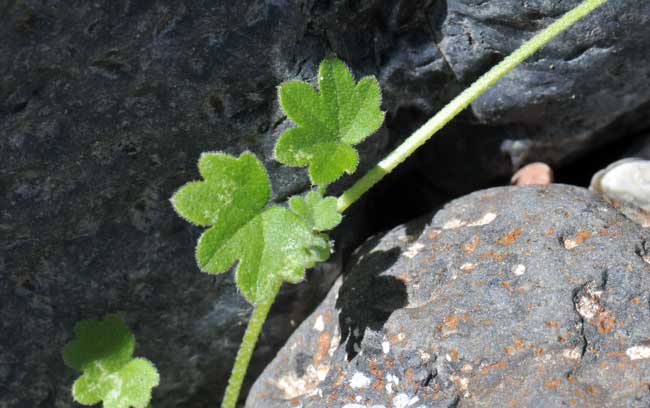Bowlesia incana, Hoary Bowlesia


Scientific Name: Bowlesia incana
Common Name: Hoary Bowlesia
Also Called: Bowlesia, Hairy Bowlesia, Miner's Lettuce
Family: Apiaceae [Umbelliferae] Parsley or Carrot Family
Synonyms: (Bowlesia septentrionalis)
Status: Native
Duration: Annual
Size: Up to 2 feet although usually not erect.
Growth Form: Forb/herb; sub-erect, stems prostrate or decumbent, up to 2 feet, foliage with stellate pubescence.
Leaves: Green; mostly opposite, kidney shaped, sub-orbicular, palmately lobed 5 to 7 lobed, stipules, petiole length variable, stellate or star-shaped pubescence.
Flower Color: Yellowish-green or greenish-white; inconspicuous, calyx lobes minute, inflorescence axillary umbel, more or less sessile, surrounding bracts lanceolate, Fruit: 2 dry, 1-seeded halves.
Flowering Season: February to May
Elevation: 1,000 to 3,500 feet.
Habitat Preferences: Common, usually among bushes and shrubs, shade of trees, rocks.
Recorded Range: In the United States, mostly in the southern, southwest and western border states; AL, AZ, CA, FL, LA, MS, NM, NV, OK, OR and TX. In Arizona, mostly in the southern, central and western parts of the state with few records in southeast Arizona. Also found in Baja California, Northwest Mexico and South America.
North America & US County Distribution Map for Bowlesia incana.
U.S. Weed Information: No data available.
Invasive/Noxious Weed Information: No data available.
Invasive/Noxious Weed Information: No data available.
Wetland Indicator: Bowlesia incana is included on the USDA 2012 National Wetland Plant List as follows; Arid West, as FACU, Atlantic and Gulf Coastal Plain, as FAC, Eastern Mountains and Piedmont, FAC, Great Plains, as FACU, Western Mountains, Valleys, and Coast, as FACU
FACU = Facultative Upland, Nonhydrophyte: Usually occur in non-wetlands, but may occur in wetlands
FAC = Facultative, Hydrophyte: Occur in wetlands and non-wetlands.
Threatened/Endangered Information: No data available.
Comments: Hoary Bowlesia is typically found growing among rocks often large rocks and growing and gaining height within existing vegetation. The running plant stems are quite weak. Flowers inconspicuous.

